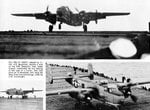FLYBOYJ
"THE GREAT GAZOO"
WRONG - you cannot simply put an arresting hook on any aircraft designed from the ground up as a land based bomber, especially a B-25. When naval aircraft are designed every bulkhead and longeron are designed to include arrestor loads and that's been the norm since the 1930s, I invite you to read Aerodynamics of the airplane by Millikan, Clark Blanchard (p1941). It's an old book but it provides a lot of stress analysis to aircraft loads and if I remember correctly there's a considerable amount of information given to loads applied to naval aircraft. For the B-25 to be completely navalized I could bet dollars to donuts that a design team would of reviewed every nut and bolt of that aircraft to see if it could withstand continual carrier operations. A twin engine carrier based aircraft stayed on North American's mind as after the war it came up with the AJ-1 Savage.syscom3 said:Its preposterous for you to think that a robust airframe like the B25 couldnt have a simple arresting hook attached to it.
Its a tricycle landing gear arrangement and not much weight is aft. Since the airframe proved more than capable of handling hard landings by student pilots (post war), its proof the airframe was solid.


